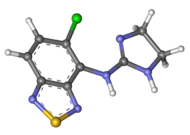 | |
 | |
| Clinical data | |
|---|---|
| Pronunciation | /taɪˈzænɪdiːn/ tye-ZAN-i-deen |
| Trade names | Zanaflex, Sirdalud, and others |
| Other names | 4-Chloro-N-(4,5-dihydro-1H-imidazol-2-yl)-8-thia-7,9-diazabicyclo[4.3.0]nona-2,4,6,9-tetraen-5-amine |
| AHFS/Drugs.com | Monograph |
| MedlinePlus | a601121 |
| Pregnancy category |
|
| Routes of administration | By mouth (tablets, capsules) |
| Legal status | |
| Legal status | |
| Pharmacokinetic data | |
| Bioavailability | ~40%[1] |
| Protein binding | ~30% |
| Metabolism | Liver (CYP1A2, 95%) |
| Elimination half-life | 2.54 hours (tizanidine), 20–40 hours (inactive metabolites)[1] |
| Excretion | Urine (60%), feces (20%) |
| Identifiers | |
| |
| Chemical and physical data | |
| Formula | C9H8ClN5S |
| Molar mass | 253.71 g·mol−1 |
| 3D model (JSmol) | |
| |
| |
| (verify) | |
Tizanidine, sold under the brand name Zanaflex among others, is a medication used to treat muscle spasticity due to spinal cord injury or multiple sclerosis.[3] Effectiveness appears similar to baclofen or diazepam.[4] It is taken by mouth.[5]
Common side effects include dry mouth, sleepiness, weakness, and dizziness.[5] Serious side effects may include low blood pressure, liver problems, psychosis, and QT prolongation.[5] It is unclear if use in pregnancy and breastfeeding is safe.[6] It is an α2-adrenergic agonist and how it works is not entirely clear.[5]
Tizanidine was approved for medical use in the United States in 1996.[5] It is available as a generic medication.[3] A month supply in the United Kingdom costs the NHS about 3.45 £ as of 2019.[3] In the United States the wholesale cost of this amount is about US$4.20.[7] In 2017, it was the 89th most prescribed medication in the United States, with more than nine million prescriptions.[8][9]
References edit
- ^ a b "Zanaflex (tizanidine hydrochloride) Capsules and Tablets for Oral Use. Full Prescribing Information" (PDF). Acorda Therapeutics Inc. Ardsley, NY 10502. Archived (PDF) from the original on 22 March 2015. Retrieved 1 September 2016.
- ^ "WHOCC - ATC/DDD Index". www.whocc.no. Archived from the original on 2 March 2019. Retrieved 6 September 2020.
- ^ a b c British national formulary : BNF 76 (76 ed.). Pharmaceutical Press. 2018. p. 1094. ISBN 9780857113382.
- ^ Kamen L, Henney HR, Runyan JD (February 2008). "A practical overview of tizanidine use for spasticity secondary to multiple sclerosis, stroke, and spinal cord injury". Current Medical Research and Opinion. 24 (2): 425–39. doi:10.1185/030079908X261113. PMID 18167175.
- ^ a b c d e "Tizanidine Hydrochloride Monograph for Professionals". Drugs.com. American Society of Health-System Pharmacists. Archived from the original on 16 June 2019. Retrieved 3 March 2019.
- ^ "Tizanidine Pregnancy and Breastfeeding Warnings". Drugs.com. Archived from the original on 3 December 2018. Retrieved 3 March 2019.
- ^ "NADAC as of 2019-02-27". Centers for Medicare and Medicaid Services. Archived from the original on 6 March 2019. Retrieved 3 March 2019.
- ^ "The Top 300 of 2020". ClinCalc. Archived from the original on 18 March 2020. Retrieved 11 April 2020.
- ^ "Tizanidine - Drug Usage Statistics". ClinCalc. Archived from the original on 8 July 2020. Retrieved 11 April 2020.